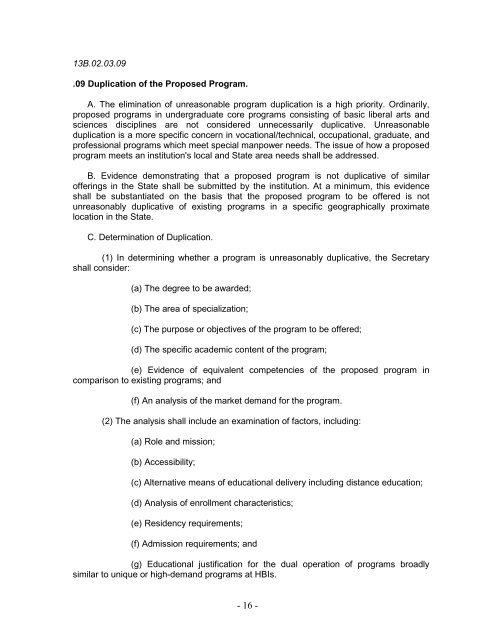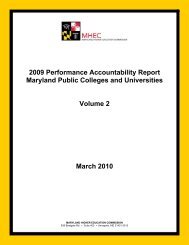COMAR Title 13B.02.03 - Maryland Higher Education Commission
COMAR Title 13B.02.03 - Maryland Higher Education Commission
COMAR Title 13B.02.03 - Maryland Higher Education Commission
You also want an ePaper? Increase the reach of your titles
YUMPU automatically turns print PDFs into web optimized ePapers that Google loves.
<strong>13B.02.03</strong>.09<br />
.09 Duplication of the Proposed Program.<br />
A. The elimination of unreasonable program duplication is a high priority. Ordinarily,<br />
proposed programs in undergraduate core programs consisting of basic liberal arts and<br />
sciences disciplines are not considered unnecessarily duplicative. Unreasonable<br />
duplication is a more specific concern in vocational/technical, occupational, graduate, and<br />
professional programs which meet special manpower needs. The issue of how a proposed<br />
program meets an institution's local and State area needs shall be addressed.<br />
B. Evidence demonstrating that a proposed program is not duplicative of similar<br />
offerings in the State shall be submitted by the institution. At a minimum, this evidence<br />
shall be substantiated on the basis that the proposed program to be offered is not<br />
unreasonably duplicative of existing programs in a specific geographically proximate<br />
location in the State.<br />
C. Determination of Duplication.<br />
(1) In determining whether a program is unreasonably duplicative, the Secretary<br />
shall consider:<br />
(a) The degree to be awarded;<br />
(b) The area of specialization;<br />
(c) The purpose or objectives of the program to be offered;<br />
(d) The specific academic content of the program;<br />
(e) Evidence of equivalent competencies of the proposed program in<br />
comparison to existing programs; and<br />
(f) An analysis of the market demand for the program.<br />
(2) The analysis shall include an examination of factors, including:<br />
(a) Role and mission;<br />
(b) Accessibility;<br />
(c) Alternative means of educational delivery including distance education;<br />
(d) Analysis of enrollment characteristics;<br />
(e) Residency requirements;<br />
(f) Admission requirements; and<br />
(g) <strong>Education</strong>al justification for the dual operation of programs broadly<br />
similar to unique or high-demand programs at HBIs.<br />
- 16 -




